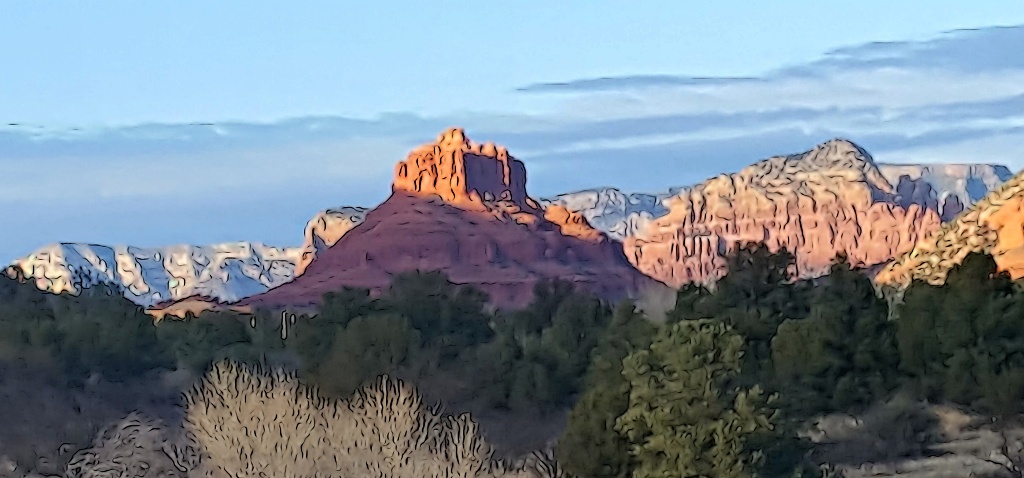| By: Paul S. Cilwa | Viewed: 5/1/2024 |
Page Views: 1134 | |
| Topics: #Arizona #Sedona | |||
| Includes Oak Creek and Oak Creek Canyon; Bell Rock. Airport Mesa, Slide Rock and more. | |||

One of Arizona's most precious jewels is the town and environs of Sedona. Nestled in a bed of red rocks jumbled from the mile-hile Mogollon Rim, Sedona is known for it's exquisite beauty as well as for metaphysical "energy vortices" with healing and enlightening powers.
Consequently, since I live less than 2 hours' drive from the place, I have made frequent visits —and always with my camera.
A Sedona Overview
| By: Paul S. Cilwa | Page Views: 998 | ||
| Topics: #Arizona #Places #Sedona | |||
| What to see in Sedona when you don't have time to see everything. | |||

Sedona, Arizona (named a century ago after the postmaster's wife) is known for its unique natural beauty, its metaphysical powers, its hiking and T-shirt shops. One could easily spend a week there doing something different every day. But many times, I must condense it all down to a single day for visiting friends with limited time. These are the photos from some of those trips.
Read more…
Montezuma Castle National Monument
| By: Paul S. Cilwa | Page Views: 1078 | ||
| Topics: #Arizona #Montezuma'sCastle | |||
| It's not a castle and it has nothing to do with Montezuma, but here we are. | |||

Montezuma's Castle National Monument was constructed by the "Sinagua" people between 1100 CE and 1425 CE. Named by European Americans in the 1860s, is not a castle and has nothing to do with the Aztec emperor, or anyone else named Montezuma. It's credited to the "Sinagua Indians", though that wasn't what they called themselves—the name was coined by archaeologists who marvelled that a people could develop a culture in the dry canyons they seemed to prefer. They were, essentially, the Anasazi people; but the Anasazi didn't call themselves "Anasazi", either. That name was given them by the Hopi and Navajo peoples, meaning as it does "enemy ancestors", which suggests the Anasazi were no strangers to family feuds which may be what tore their culture apart.)
Read more…
Splashing in Oak Creek
| By: Paul S. Cilwa | Posted: 7/6/2008 |
Page Views: 1218 | |
| Topics: #Arizona #Camping #OakCreek #Photography #Sedona #SlideRockStatePark #Zachary | |||
| What could be more fun that splashing in a natural creek with one's grandson? | |||
On July 4th, the members of our extended family were scattered. Michael and I attended a terrific pool party hosted by our friend, Jay, which included the most divine pasta dishes (which I shouldn't have eaten, but did). Zach and his Mom and grandmother went to Zach friend Chris' house for barbecue and to watch the fireworks (though Zach pooped out before the fireworks started). Karen continued to house sit.
Read more…
Slide Rock
| By: Paul S. Cilwa | Posted: 8/13/2007 |
Page Views: 1462 | |
| Topics: #Arizona #Sedona #SlideRock #SlideRockStatePark #Travel | |||
| The whole damnfamily visits Sedona's favorite state park. | |||

My son's girlfriend, Rachel, is from Texas and wanted to see Sedona. So we arranged to make the expedition yesterday.
Read more…
Tuzigoot National Monument
| By: Paul S. Cilwa | Page Views: 1076 | ||
| Topics: #Tuzigoot | |||
| An 850-year-old archaeological treasure. How early Native Americans lived. | |||

Tuzigoot National Monument preserves a 2- to 3-story pueblo ruin on the summit of a limestone and sandstone ridge just east of Clarkdale, Arizona, 120 feet above the Verde River floodplain. The Tuzigoot Site is an elongated complex of stone masonry rooms that were built along the spine of a natural outcrop in the Verde Valley. The central rooms stand higher than the others and they appear to have served public functions. The pueblo has 110 rooms.
Read more…
Vortexes
| By: Paul S. Cilwa | Page Views: 3055 | ||
| Topics: #Arizona #Metaphysics #Places #Sedona #Vortexes | |||
| All about the Sedona energy vortexes and what they mean. | |||

Approximately 260 million years ago, during the Permian Period, the geographic area currently known as Sedona, Arizona, was at the bottom of a shallow sea, where layer after layer of iron-rich sandstone was laid down. The sandstone, known today as the Schnebly Hill Formation, was later eroded when the land rose above the sea into the fantasic shapes one sees today in the brilliant red-and-orange Sedona rock formations. But, more than that, some of the formations extend so deeply into the Earth that they conduct subtle energies to the surface, where people can use them for healing and/or spiritual development.
Read more…





